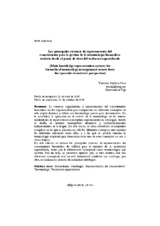Mostrar el registro sencillo del ítem
Los principales sistemas de representación del conocimiento para la gestión de la terminología biomédica: revisión desde el punto de vista del traductor especializado
| dc.contributor.author | Varela Vila, Tamara | |
| dc.date.accessioned | 2020-05-27T13:04:22Z | |
| dc.date.available | 2020-05-27T13:04:22Z | |
| dc.date.issued | 2019 | |
| dc.identifier.issn | 2386-9658 | |
| dc.identifier.uri | http://hdl.handle.net/10396/20029 | |
| dc.description.abstract | La correcta organización y representación del conocimiento biomédico resulta imprescindible para comprender los diferentes conceptos de este amplio dominio y utilizar una terminología precisa para denominarlos. En la actualidad, la aplicación en el ámbito de la terminología de las nuevas modalidades de representación conceptual, especialmente las ontologías, facilita el diseño de sistemas conceptuales dinámicos y multidimensionales independientes de la lengua. De este modo, se crean estructuras conceptuales complejas en las que se plasman no solo los diferentes conceptos sino también las relaciones existentes entre ellos, y a las que es posible vincular la terminología empleada para denominar cada uno de estos conceptos en una o varias lenguas. En este artículo se revisan los principales sistemas de representación del conocimiento biomédico de utilidad para el ejercicio de la traducción especializada, tanto por la información conceptual como terminológica que aportan. Por un lado, se presentan aquellos que, si bien cuentan con una estructura conceptual, esta no está formalizada mediante una ontología; por otro, se analizan los sistemas de naturaleza ontológica. | es_ES |
| dc.description.abstract | The correct organisation and representation of the biomedical knowledge is essential for understanding the different concepts of this large domain as well as for using an accurate terminology to designate those. Nowadays, the application in the field of terminology of the new ways of conceptual representation, especially ontologies, facilitates the creation of dynamic and multidimensional conceptual systems independent from language. In this way, complex conceptual structures can be created to reflect, not just the different concepts, but also the existent relationships between them, with the possibility of linking those to the terminology used to designate each of these concepts in one or several languages. This paper reviews the main representation systems of biomedical knowledge useful for specialised translation, both for the conceptual and terminological information they provide. On the one hand, systems with a conceptual structure but without an ontology are presented. On the other hand, systems of an ontological nature are analysed. | es_ES |
| dc.format.mimetype | application/pdf | es_ES |
| dc.language.iso | spa | es_ES |
| dc.publisher | UCOPress | es_ES |
| dc.rights | https://creativecommons.org/licenses/by/3.0/ | es_ES |
| dc.source | Alfinge 31, 119-141 (2019) | es_ES |
| dc.subject | Biomedicina | es_ES |
| dc.subject | Ontologías | es_ES |
| dc.subject | Representación del conocimiento | es_ES |
| dc.subject | Terminología | es_ES |
| dc.subject | Traducción especializada | es_ES |
| dc.subject | Biomedicine | es_ES |
| dc.subject | Ontologies | es_ES |
| dc.subject | Knowledge representation | es_ES |
| dc.subject | Terminology | es_ES |
| dc.subject | Specialised translation | es_ES |
| dc.title | Los principales sistemas de representación del conocimiento para la gestión de la terminología biomédica: revisión desde el punto de vista del traductor especializado | es_ES |
| dc.title.alternative | Main knowledge representation systems for biomedical terminology management: review from the specialist translator’s perspective | es_ES |
| dc.type | info:eu-repo/semantics/article | es_ES |
| dc.relation.publisherversion | https://www.uco.es/ucopress/ojs/index.php/alfinge/index | es_ES |
| dc.rights.accessRights | info:eu-repo/semantics/openAccess | es_ES |

